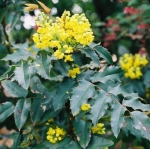| Common Name: |
Holly Mahonia |
| Other Names: |
California Barberry, Creeping Barberry, Holly-Leaved Barberry, Mountain Grape, Oregon Grape, Wild Oregon Grape |
| Botanical Name: |
Mahonia aquifolium |
| Genus: |
Mahonia |
| Family: |
Berberidaceae |
| Native Location: |
Native to western N America |
| Cultivation: |
Well-drained, rich soil in sun or partial shade. Mahonia aquifolium colors better in winter when planted in full sun. Cut back groundcover plants and old, straggly specimens hard in spring. Leafspot, powdery mildew, and rust may attack foliage. |
| Propagation: |
By seed sown in autumn (species only); by leaf-bud or semi-ripe cuttings from late summer to autumn. |
| Harvest: |
Roots and root bark are collected in late autumn or early spring, and dried for use in decoctions and liquid extracts. Fruits are collected when ripe and used fresh. |
| Variations: |
Apollo
Is vigourous, with a dense spreading habit, good for use as a groundcover; red-stalked, brown-tinged leaves that turn bronze in winter; and large clusters of bright yellow flowers.
Height: 60cm (24in) |
Compactum
Has glossier leaves that turn bronze in winter.
Height: 60-90cm (24-36in) |
Moseri
Has red-orange new foliage. |
Smaragd
syn.Emerald
Is compact, with large clusters of flowers.
Height: 60cm (24in)
Width: 1m (3ft) |
|
| Height: |
1-1.5m (3-5ft) |
| Width: |
1.5-2m (5-6ft) |
| Hardiness: |
Z5-8 |
| History: |
Do not confuse this kissing cousin of barberry (Berberis vulgaris) with the true grape (Vitis vinifera). The edible purple berries of Oregon grape—a beautiful, yellow-blossomed native of North America—are kin to the berries of the barberry family (Berberidaceae), although they can be made into juices and preserves just like "real" grapes. Oregon Grape was, in fact, a member of the larger Berberis plant genus for many years, until it was assigned a genus of its own, Mahonia, in honor of the celebrated, early nineteenth-century American horticulturist Bernard McMahon. The roots and rhizomes of Oregon grape were used for centuries by Native American healers to treat debilitation, indigestion, kidney ailments, poor appetite, skin diseases, stomach ulcers, and rheumatism. Early American settlers soon discovered the herb's healing powers, and the plant made its way to Europe in the early 1800s, where it is now naturalized. Oregon grape was especially prized as a bracing tonic and a "blood purifier"—indeed, one of its common Spanish names is yerba de la sangre, or "herb of the blood". Like barberry, Oregon grape contains the powerful antibiotic berberine, but in lower concentrations. This makes it less effective than barberry against bacterial infections, but it is a more potent liver and blood tonic. Oregon grape is an especially good treatment for chronic and scaly skin conditions, such as psoriasis, that are sometimes linked to impaired liver function and toxins in the blood. |
| Parts Used: |
Roots, root bark, fruits. |
| Properties: |
A bitter, astringent, decongestant herb that stimulates bile flow and releases toxins. |
| Medicinal Uses: |
Internally for skin diseases (especially dry eczema), gall bladder complaints, chronic hepatitis B, catarrhal gastritis, and diarrhea.
Oregon grape has anti-inflammatory, antiseptic, astringent, blood-detoxifying, decongestant, diuretic, laxative, and tonic properties. It also increases the flow of bile to the intestines and helps the liver rid the body of toxins. Oregon grape is taken internally as a liver tonic and blood purifier, and to treat acne, constipation, dermatitis, diarrhea, eczema, gallbladder ailments, gastritis, hepatitis B, herpes simplex, psoriasis, and rheumatism. |
| Preparation: |
Oregon grape is available as dried herb and in teas and tinctures. To make a decoction, add ½ teaspoon of dried rootstock to 1 cup of water and boil for 5 minutes. Strain, and let cool to room temperature. Take 1 tablespoon four times a day. |
| Caution: |
Oregon grape stimulates the liver. If you have, or suspect you have impaired liver function or liver disease, consult a qualified medical practitioner before using Oregon grape. |
| Culinary Uses: |
Berries are added to fruit pies, jams, and jellies; they are also pressed for juice, which is added to fruit drinks or made into wine. |
| Bibliography: |
Encyclopedia of Herbs by Deni Brown Copyright © 1995, 2001 Dorling Kindersley Limited Pg 270
The Modern Herbal Primer by Nancy Burke Copyright©2000 Yankee Publishing, Inc. pp. 118-119
|
